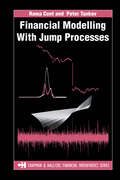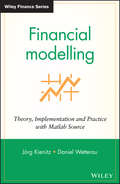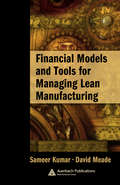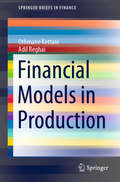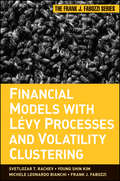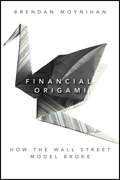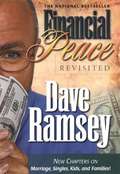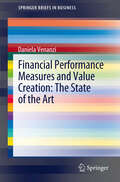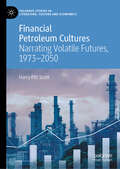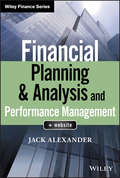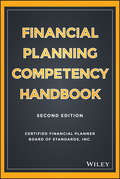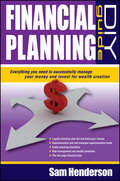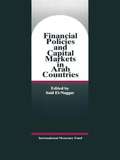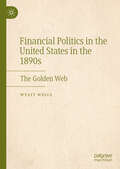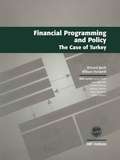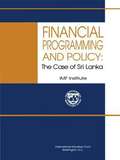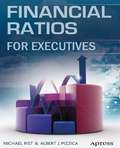- Table View
- List View
Financial Modelling with Jump Processes (Chapman and Hall/CRC Financial Mathematics Series)
by Rama Cont Peter TankovWINNER of a Riskbook.com Best of 2004 Book Award!During the last decade, financial models based on jump processes have acquired increasing popularity in risk management and option pricing. Much has been published on the subject, but the technical nature of most papers makes them difficult for nonspecialists to understand, and the mathematic
Financial Modelling: Theory, Implementation and Practice with MATLAB Source (The Wiley Finance Series)
by Daniel Wetterau Joerg KienitzFinancial Modelling - Theory, Implementation and Practice is a unique combination of quantitative techniques, the application to financial problems and programming using Matlab. The book enables the reader to model, design and implement a wide range of financial models for derivatives pricing and asset allocation, providing practitioners with complete financial modelling workflow, from model choice, deriving prices and Greeks using (semi-) analytic and simulation techniques, and calibration even for exotic options.The book is split into three parts. The first part considers financial markets in general and looks at the complex models needed to handle observed structures, reviewing models based on diffusions including stochastic-local volatility models and (pure) jump processes. It shows the possible risk neutral densities, implied volatility surfaces, option pricing and typical paths for a variety of models including SABR, Heston, Bates, Bates-Hull-White, Displaced-Heston, or stochastic volatility versions of Variance Gamma, respectively Normal Inverse Gaussian models and finally, multi-dimensional models. The stochastic-local-volatility Libor market model with time-dependent parameters is considered and as an application how to price and risk-manage CMS spread products is demonstrated.The second part of the book deals with numerical methods which enables the reader to use the models of the first part for pricing and risk management, covering methods based on direct integration and Fourier transforms, and detailing the implementation of the COS, CONV, Carr-Madan method or Fourier-Space-Time Stepping. This is applied to pricing of European, Bermudan and exotic options as well as the calculation of the Greeks. The Monte Carlo simulation technique is outlined and bridge sampling is discussed in a Gaussian setting and for Lévy processes. Computation of Greeks is covered using likelihood ratio methods and adjoint techniques. A chapter on state-of-the-art optimization algorithms rounds up the toolkit for applying advanced mathematical models to financial problems and the last chapter in this section of the book also serves as an introduction to model risk. The third part is devoted to the usage of Matlab, introducing the software package by describing the basic functions applied for financial engineering. The programming is approached from an object-oriented perspective with examples to propose a framework for calibration, hedging and the adjoint method for calculating Greeks in a Libor Market model.Source code used for producing the results and analysing the models is provided on the author's dedicated website, http://www.mathworks.de/matlabcentral/fileexchange/authors/246981
Financial Models and Tools for Managing Lean Manufacturing (Supply Chain Integration Modeling, Optimization and Application)
by David MeadeThe effect Lean Manufacturing programs have on profit and loss statements during the early months of their implementation often causes them to be viewed as failures. The length of time it will take traditional financial reports to reflect lean manufacturing improvements depends upon how poorly the operation was doing in terms of inventory managemen
Financial Models in Production (SpringerBriefs in Finance)
by Adil Reghai Othmane KettaniThis book provides a hands-on guide to how financial models are actually implemented and used in practice, on a daily basis, for pricing and risk-management purposes. It shows how to put these models into use in production while minimizing the cost of implementation and maximizing robustness and control. Addressing some of the most important and cutting-edge issues, it describes how to build the necessary models in order to risk manage all the costs involved in options fabrication within the world of equity derivatives and hybrids. This is achieved by extending classical models and improving them in order to account for complex features. The book is primarily aimed at market practitioners (traders, risk managers, risk control, top managers), as well as Masters students in Quantitative/Mathematical Finance. It will also be useful for instructors hoping to enrich their courses with practical examples. The prerequisites are basic stochastic calculus and a general knowledge of financial markets and financial derivatives.
Financial Models with Levy Processes and Volatility Clustering
by Svetlozar T. Rachev Frank J. Fabozzi Michele L. Bianchi Young Shin KimAn in-depth guide to understanding probability distributions and financial modeling for the purposes of investment managementIn Financial Models with Lévy Processes and Volatility Clustering, the expert author team provides a framework to model the behavior of stock returns in both a univariate and a multivariate setting, providing you with practical applications to option pricing and portfolio management. They also explain the reasons for working with non-normal distribution in financial modeling and the best methodologies for employing it.The book's framework includes the basics of probability distributions and explains the alpha-stable distribution and the tempered stable distribution. The authors also explore discrete time option pricing models, beginning with the classical normal model with volatility clustering to more recent models that consider both volatility clustering and heavy tails.Reviews the basics of probability distributionsAnalyzes a continuous time option pricing model (the so-called exponential Lévy model)Defines a discrete time model with volatility clustering and how to price options using Monte Carlo methodsStudies two multivariate settings that are suitable to explain joint extreme eventsFinancial Models with Lévy Processes and Volatility Clustering is a thorough guide to classical probability distribution methods and brand new methodologies for financial modeling.
Financial Organization and Operations of the IMF
by International Monetary FundA report from the International Monetary Fund.
Financial Origami
by Brendan MoynihanAn in-depth look at the failure of Wall Street's "proven" financial models Origami is the Japanese art of folding paper into intricate and aesthetically attractive shapes. As such, it is the perfect metaphor for the Wall Street financial engineering model, which ultimately proved to be the underlying cause of the 2008 financial crisis. In Financial Origami, Brendan Moynihan describes how the Wall Street business model evolved from a method to transfer risk into a method for manufacturing risk. Along the way, this timely book skillfully dissects financial engineering and addresses how it's often a mechanism to evade regulatory constraints, provide institutional investors with customized products, and, of course, generate revenue for financial engineers. Reveals how Wall Street's financial engineering business model morphed into something destructive Highlights how the origami model worked well in the comparatively stable years of the early 2000s, when there was less risk to transfer Discusses how Wall Street began manufacturing risk by creating products that multiplied risk exposures and encouraged subprime lending With the collapse of Lehman Brother the Wall Street business model effectively broke. But there are many lessons to be learned from what has transpired, and Financial Origami will show you what they are.
Financial Peace Revisited
by Dave RamseyDave Ramsey knows what it's like to have it all. By age twenty-six, he had established a four-million-dollar real estate portfolio, only to lose it by age thirty. He has since rebuilt his financial life and, through his workshops and his New York Times business bestsellers Financial Peace and More than Enough, he has helped hundreds of thousands of people to understand the forces behind their financial distress and how to set things right--financially, emotionally, and spiritually. In this new edition of Financial Peace, Ramsey has updated his tactics and philosophy to show even more readers: how to get out of debt and stay out, the KISS rule of investing--"Keep It Simple, Stupid" how to use the principle of contentment to guide financial decision making how the flow of money can revolutionize relationships. With practical and easy to follow methods and personal anecdotes, Financial Peace is the road map to personal control, financial security, a new, vital family dynamic, and lifetime peace.
Financial Peace Revisited: New Chapters on Marriage, Singles, Kids and Families
by Dave RamseyDave Ramsey knows what it's like to have it all. By age twenty-six, he had established a four-million-dollar real estate portfolio, only to lose it by age thirty. He has since rebuilt his financial life and, through his workshops and his New York Times business bestsellers Financial Peace and More than Enough, he has helped hundreds of thousands of people to understand the forces behind their financial distress and how to set things right-financially, emotionally, and spiritually.In this new edition of Financial Peace, Ramsey has updated his tactics and philosophy to show even more readers:how to get out of debt and stay outthe KISS rule of investing--"Keep It Simple, Stupid"how to use the principle of contentment to guide financial decision makinghow the flow of money can revolutionize relationshipsWith practical and easy to follow methods and personal anecdotes, Financial Peace is the road map to personal control, financial security, a new, vital family dynamic, and lifetime peace.
Financial Performance Measures and Value Creation: the State of the Art
by Daniela VenanziThe choice of financial performance measures is one of the most critical challenges facing organizations. The accounting-based measures of financial performance have been viewed as inadequate, as firms began focusing on shareholder value as the primary long-term objective of the organization. Hence, value-based metrics were devised that explicitly incorporate the cost of capital into performance calculations. Despite the increasing emphasis on these value-based measures, no definitive evidence exists of which metric works better than others, and on the extent to which any of them is superior to traditional accounting measures. In this scenario, the objective of this book is contributing to the ongoing dialogue on the appropriateness of different financial performance measures, by providing a systematic and updated review of the major value-based measures, by highlighting their respective strengths and weaknesses and by comparing the main international empirical evidence on their effectiveness. This book can be a powerful tool for guiding managers and graduate students in the "tangled forest" of the existing metrics, by providing them with the quick, but adequate knowledge for consistently adopting them.
Financial Perspective
by Robert S. Kaplan David P. NortonFinancial objectives represent the long-term goal of the organization: to provide superior returns based on the capital invested in the unit. Building a Balanced Scorecard should encourage business units to link their financial objectives to corporate strategy. This chapter looks at the dual role financial objectives and measures must play, defining the financial performance expected from the strategy, and serving as the ultimate targets for the objectives and measures of all the other scorecard perspectives. This chapter was originally published as chapter 3 of "The Balanced Scorecard: Translating Strategy into Action."
Financial Petroleum Cultures: Narrating Volatile Futures, 1973–2050 (Palgrave Studies in Literature, Culture and Economics)
by Harry Pitt ScottFinancial Petroleum Cultures draws upon literature, film, architecture, photography, infrastructure, advertisements, and financial reports to explore how financial narratives shape the future of energy and climate. Using frameworks from the energy, environmental, and economic humanities, the book argues that financial representations dominate contemporary petroleum cultures. It focuses on the competing narratives of finance, celebratory and critical, determining how energy is perceived, imagined, and used. Encompassing critiques of ideology and infrastructure, this book offers a new understanding of the political visions enabled and constrained by the financial sector in an increasingly volatile world.
Financial Planning & Analysis and Performance Management (Wiley Finance)
by Jack AlexanderCritical insights for savvy financial analysts Financial Planning & Analysis and Performance Management is the essential desk reference for CFOs, FP&A professionals, investment banking professionals, and equity research analysts. With thought-provoking discussion and refreshing perspective, this book provides insightful reference for critical areas that directly impact an organization’s effectiveness. From budgeting and forecasting, analysis, and performance management, to financial communication, metrics, and benchmarking, these insights delve into the cornerstones of business and value drivers. Dashboards, graphs, and other visual aids illustrate complex concepts and provide reference at a glance, while the author’s experience as a CFO, educator, and general manager leads to comprehensive and practical analytical techniques for real world application. Financial analysts are under constant pressure to perform at higher and higher levels within the realm of this consistently challenging function. Though areas ripe for improvement abound, true resources are scarce—until now. This book provides real-world guidance for analysts ready to: Assess performance of FP&A function and develop improvement program Improve planning and forecasting with new and provocative thinking Step up your game with leading edge analytical tools and practical solutions Plan, analyze and improve critical business and value drivers Build analytical capability and effective presentation of financial information Effectively evaluate capital investments in uncertain times The most effective analysts are those who are constantly striving for improvement, always seeking new solutions, and forever in pursuit of enlightening resources with real, useful information. Packed with examples, practical solutions, models, and novel approaches, Financial Planning & Analysis and Performance Management is an invaluable addition to the analyst’s professional library. Access to a website with many of the tools introduced are included with the purchase of the book.
Financial Planning Competency Handbook
by Cfp BoardThe official guide for exam success and career excellence Financial Planning Competency Handbook, Second Edition is the essential reference for those at any stage of certification and a one-stop resource for practitioners looking to better serve their clients. This fully updated second edition includes brand new content on connections diagrams, new case studies, and new instructional videos, and a completely new section devoted to the interdisciplinary nature of financial planning. You'll gain insights from diverse fields like psychology, behavioral finance, communication, and marriage and family therapy to help you better connect with and guide your clients, alongside the detailed financial knowledge you need to perform to the highest expectations as a financial planner. This book contains over ninety chapters that are essential for practitioners, students, and faculty. Whether a practitioner, student, or faculty member, this guide is the invaluable reference you need at your fingertips. Comprehensive, clear, and detailed, this handbook forms the foundation of the smart financial planner's library. Each jurisdiction has its own laws and regulations surrounding financial planning, but the information in this book represents the core body of knowledge the profession demands no matter where you practice. Financial Planning Competency Handbook, Second Edition guides you from student to practitioner and far beyond, with the information you need when you need it.
Financial Planning DIY Guide: Everything You Need to Successfully Manage Your Money and Invest for Wealth Creation
by Sam HendersonFinancial Planning DIY Guide is the only Australian all-in-one handbook to getting the most from your money. Written by expert financial planner Sam Henderson, this comprehensive guide will help you build and manage your assets no matter what your stage of life, and show you how to create your own one-page financial plan and put it into practice.
Financial Planning, Budgeting and Forecasting/Financial Intelligence Collection
by David A. Moss Karen Berman Joe Knight Jeremy Hope Robin Fraser Joseph H. EllisDon’t let your fear of finance get in the way of your success. This digital collection, curated by Harvard Business Review, brings together everything a manager needs to know about financial intelligence. It includes Financial Intelligence, called a “must-read” for decision makers without expertise in finance; A Concise Guide to Macroeconomics, which covers the essentials of macroeconomics and examines the core ideas of output, money, and expectations; Essentials of Finance and Budgeting, which explains everything HR professionals need to know to make wise financial decisions; Ahead of the Curve, Joseph H. Ellis’s forecasting method to help managers and investors understand and predict the economic cycles that control their businesses and financial fates; Beyond Budgeting; which offers a coherent management model that overcomes the limitations of traditional budgeting; Preparing a Budget, packed with handy tools, self-tests, and real life examples to help you hone critical skills; and HBR Guide to Finance Basics for Managers, which will give you the tools and confidence you need to master the fundamentals of finance.
Financial Policies and Capital Markets Arab Countries
by Said El-NaggarA report from the International Monetary Fund.
Financial Policy at Apple, 2013 (A)
by Mihir A. Desai Elizabeth A. MeyerBy the end of 2013, Apple had $137 billion dollars in cash and marketable securities. This case explores how companies can generate such large amounts of cash and how and if they should distribute it to shareholders, especially in the face of shareholder pressure. In the process, students are asked to undertake fundamental financial analyses, including ratio analysis, a financial forecast, and a cash distribution analysis.
Financial Policy at Apple, 2013 (B)
by Mihir A. Desai Elizabeth A. MeyerThis case is meant to accompany Financial Policy at Apple, 2013 (A) and details the results of Apple's Q2 2013 earnings call.
Financial Politics in the United States in the 1890s: The Golden Web
by Wyatt WellsIn the 1890s, the choice between the gold standard and the free coinage of silver upended American politics. The gold standard linked the United States to the larger international financial system, in which gold was the common denominator. The free coinage of silver would effectively sever these ties by devaluing the dollar. The gold standard allowed the U.S. to secure vast amounts of foreign capital on good terms to build railroads and develop industry, but at the cost of deflation. The free coinage of silver would raise prices, particularly for cotton and wheat, whose cultivators carried heavy debts and were hard-pressed. The struggle would define the United States. Would it continue to develop industrially, or would it return to its agricultural roots? The combatants—among them Grover Cleveland, William Jennings Bryan, J.P. Morgan, and William McKinley—understood what was at stake. This book deals both with well-known aspects of the contest, such as the 1896 Presidential election between McKinley and Bryan, and lesser-known ones, such as how the currency issues interacted with racial politics and international negotiations over the role of silver in the world&’s monetary system. The result is the most comprehensive account of financial politics in the United States in the 1890s yet published.
Financial Prep 101: Simple Tips for the Next Generation
by Janis R DickeyStep into the future of finance with Financial Prep 101: Simple Tips for the Next Generation.This practical workbook serves as your guide to financial freedom, demystifying the often-intimidating world of finance with straightforward explanations. Designed for both teens and adults, this easy-to-read resource brings clarity to essential financial terms and concepts that everyone should know.Navigate everyday financial choices with ease as you learn about budgeting, saving, investment strategies, financing and borrowing options, retirement planning, and safeguarding your wealth.Don&’t miss out on your pathway to financial literacy and success – your blueprint for a secure financial future starts here!
Financial Products: An Introduction Using Mathematics and Excel
by Bill DaltonFinancial Products, first published in 2008, provides a step-by-step guide to some of the most important ideas in financial mathematics. It describes and explains interest rates, discounting, arbitrage, risk neutral probabilities, forward contracts, futures, bonds, FRA and swaps. It shows how to construct both elementary and complex (Libor) zero curves. Options are described, illustrated and then priced using the Black Scholes formula and binomial trees. Finally, there is a chapter describing default probabilities, credit ratings and credit derivatives (CDS, TRS, CSO and CDO). An important feature of the book is that it explains this range of concepts and techniques in a way that can be understood by those with only a basic understanding of algebra. Many of the calculations are illustrated using Excel spreadsheets, as are some of the more complex algebraic processes. This accessible approach makes it an ideal introduction to financial products for undergraduates and those studying for professional financial qualifications.
Financial Programming and Policy
by William Hemphill Richard BarthA series of workshops introducing readers to the process of formulating a macroeconomic adjustment programme, designed to move a country toward internal and external balance. Turkey is a middle income developing country which has made great progress towards industrialisation, but not without setbacks and stabilisation problems. It therefore presents a wide range of relevant issues for study.
Financial Programming and Policy: The Case of Sri Lanka
by John KarlikA report from the International Monetary Fund.
Financial Ratios for Executives
by Rist Michael Pizzica Albert J.Financial Ratios for Executives is written specifically with today's global executive in mind. It makes financial ratios easy to understand and use effectively. This short book will prove invaluable to both financial and non-financial executives looking for easy, intuitive methods to assess corporate health and assist in strategic decision making. Financial Ratios for Executives contains over 100 financial ratios and other useful calculations. It includes ratios that are commonly used, such as return on investment (ROI), return on assets (ROA), return on equity (ROE), economic value added (EVA), and debt-to-equity ratio, just to name a few. It also includes many less-well known--yet powerful--ratios that can provide unparalleled insight into operations, financial management, sales and marketing efforts, and overall performance, among other areas. Using realistic financial and operational data from two fictional companies, the explanation of each ratio includes: Type of ratio Formula for calculating the ratioDescription of the ratioExample based on ABC Company or XYZ CompanyAdditional comments or insightsIn addition to the section on financial ratios, financial experts Michael Rist and Albert Pizzica have included a section on capital budgeting, an understanding of which is essential for both the financial and non-financial executives before they take part in an annual budget meeting or any other business meeting where capital allocation is discussed. It includes the most important tools of finance, such as net present value (NPV), internal rate of return (IRR), payback method, and total cost of ownership. Who gets ahead in the business world? Those who understand the numbers. It's as simple as that. Financial Ratios for Executives is for those who want to understand how to use financial data to support their initiatives, solve persistent problems, uncover opportunities, bolster company health, and shine in corporate meetings.
